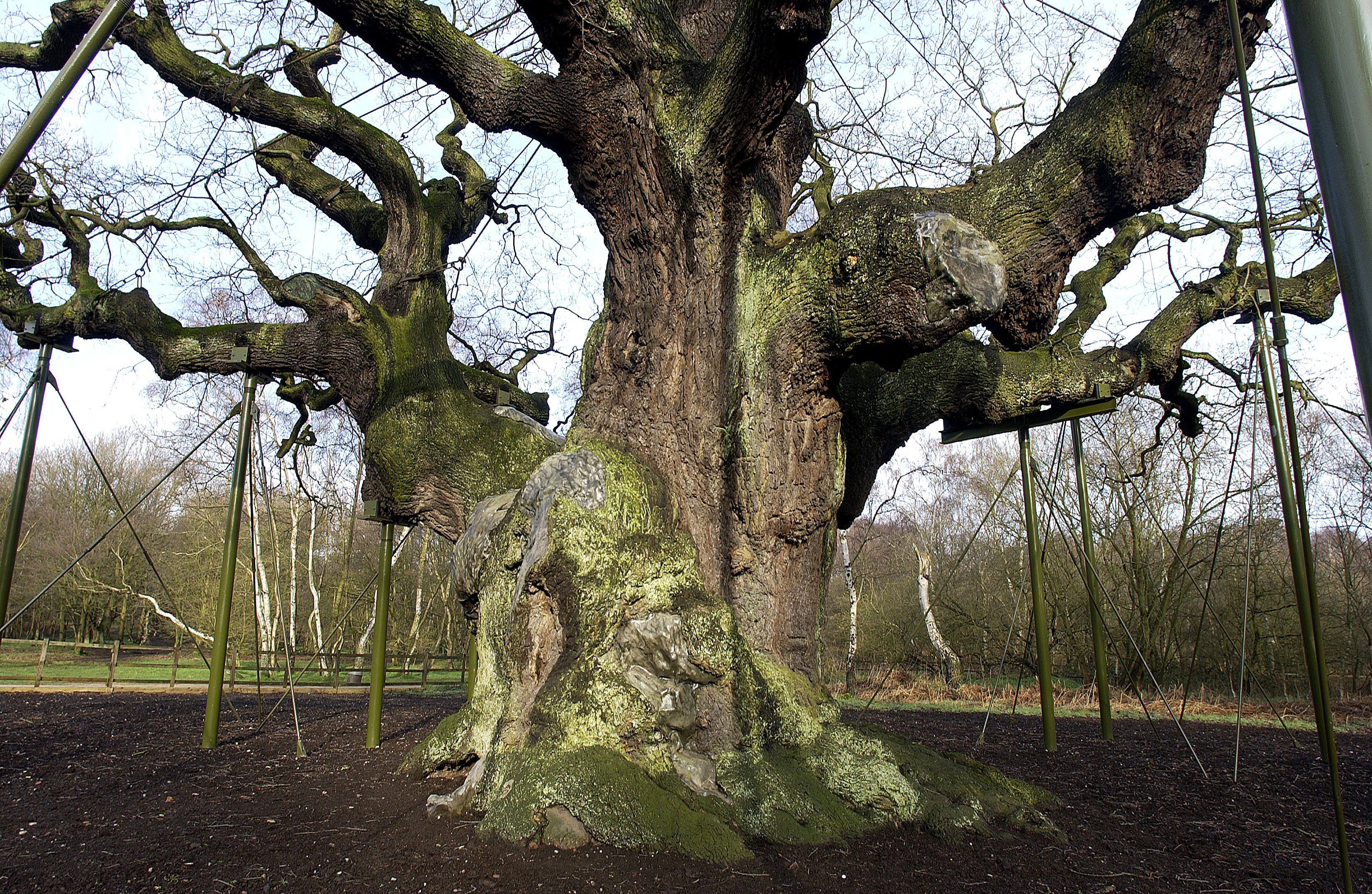Lime
Lime includes our native species; the small leaved lime (Tilia cordata) and large leaved lime (Tilia platyphyllos). Also included are the different clones of common lime (Tilia x europaea) which are most frequently found in avenues (see below for more guidance on common lime).
Another lime species commonly found as a large tree in parks and gardens is the silver weeping lime, also called silver pendant lime (Tilia tomentosa ‘Petiolaris’) and the, less frequently found, silver lime (Tilia tomentosa). Where the species is unknown the tree can be recorded simply as lime and with enough photographs can be identified.

Ancient Small leaved lime pollard in a historic parkland. (Photo: ATI website)
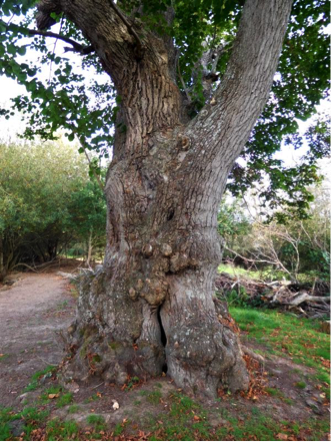
Veteran large leaved lime in a park. (Photo: ATI website)
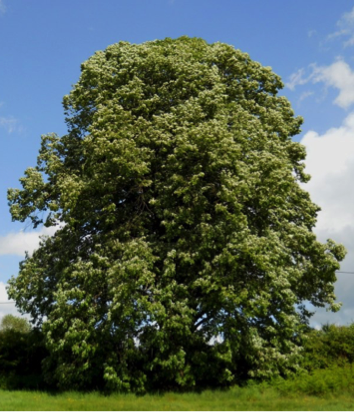
Notable silver lime in a garden. (Photo: Stephen Young)
Distribution
Our native lime species are naturally found throughout England and into the east of Wales but only as a planted tree in Scotland and elsewhere. Large leaved lime is the rarest and although planted for several hundred years most ancient trees are confined to woodland coppice on chalk or limestone soils. Small leaved lime is prolific as a coppiced tree in ancient woodland and locally abundant as old pollards. They have been recorded on the limestone scars in the Yorkshire Dales.
Common lime is now, since the demise of elm in the 1970’s, the most frequently found avenue on country estates throughout the UK. A fashionable planted tree since the late 1600’s.

Ancient small leaved lime coppice in Owston Woods, Leicestershire. (Photo: ATI website)
Typical location
Ancient woodland, parks and gardens, avenues and as urban street trees.
Age
As a maiden tree a lime may live for 300-400 years, whilst most claims of older trees will be regenerating as coppice or from layered younger branches. The oldest of these may go back over 500 years as re-occurring coppice. At Westonbirt Arboretum there is a clump of regularly cut coppice in Silk wood that experts claim are all from one tree that originally grew there more than 2,000 years ago.
All lime are classed as ancient from 300 years onwards, although many will have ancient characteristics from around 250 years.
Typically a veteran lime will be 150-250 years of age and a notable lime may be 100-175 years old.
Left: The overall appearance of ancient lime will vary considerably depending on tree form, as demonstrated by this ancient coppice!
Girth size
Specimens can be found up to 6m plus in girth. General guidance is to record all lime more than 4.25m in girth but consider recording a tree with ancient characteristics and a girth of more than 3m, particularly if a pollard.
It’s important to rely on characteristics rather than size, which can be an unreliable indication of age. Most ancient lime are greater than 5m in girth if they grow as a maiden whilst lime that have been previously managed as a pollard, or within a close planted avenue, may be no more than 3.25m in girth.

(Photo: Judy Dowling)

(Photo: David Alderman)
Left: A specimen lime with lots of veteran characteristics.
Above: An avenue of common lime with very few veteran features. Planted in 1840 they are early veteran by age, whilst being notable by condition. Here the default for recording was “notable” with individual trees being “veteran” depending upon the features recorded. The avenue itself is recognised as a heritage feature and so the value of all of the trees is recognised.
Below: One of the most well known lime trees is the Queen Elizabeth Lime, a large leaved lime, at Burghley House, Cambridgeshire (near Stamford, Lincs). Planted by Queen Elizabeth I in c.1580 the tree we see today is believed to be a layered branch from the original.

The Queen Elizabeth Tree at Burghley House, a tree with ancient origins. (Photo: Desmond Quinn)
Ancient characteristics of lime trees
- Girth is large
- Major trunk cavities or progressive hollowing
- Decay holes
- Aerial roots inside a hollow trunk that have become new supporting stems
- Bark loss
- Large quantities of dead wood in the canopy
- Crevices in the bark, under branches or on the root plate, sheltered from direct rainfall
- Fungal fruiting bodies (from heart rotting species)
- A high number of interdependent wildlife species
In addition, lime trees may also have
- A pollard form or show indications of past management
- A prominent position in the landscape
- Been part of a historic avenue
- Mistletoe
See below for examples of lime trees that are displaying ancient and veteran characteristics:

Ancient Small leaved lime coppice in ancient woodland (Photo: David Alderman)

A surviving remnant from a common lime planted as part of an avenue in the 17th century (Photo: Tom Reed)

A fragmented ancient hollow parkland small leaved lime in a medieval deer park. (Photo: David Alderman)

A common lime surrounded by a ring of self-layered branches. Some examples of layering may have been deliberate where the tree was an individual focal point. (Photo: Clair McFarlan)
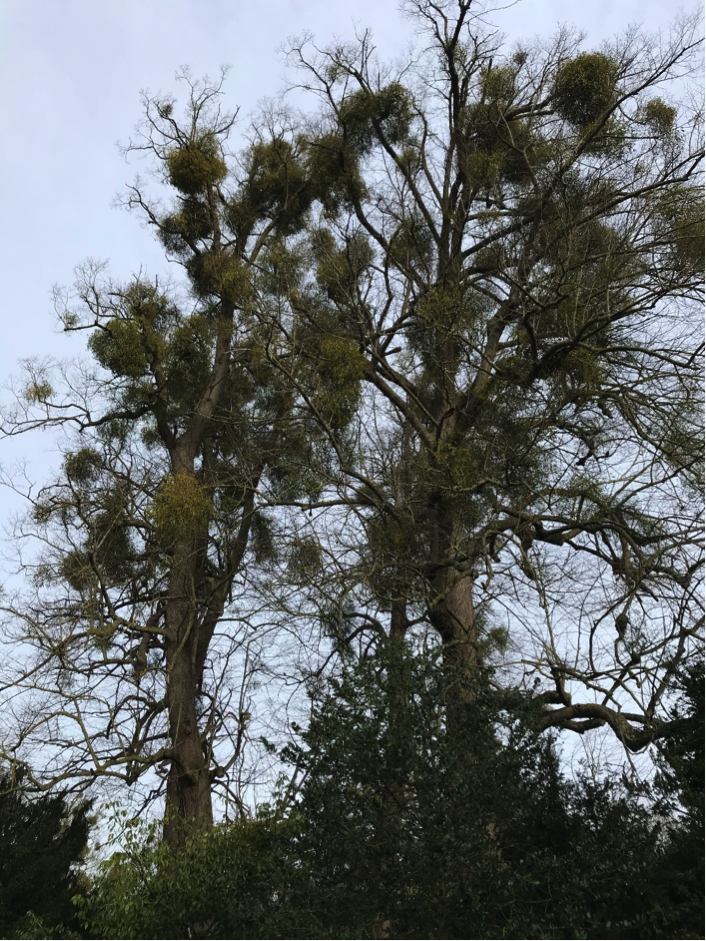
Mistletoe is frequently seen in lime trees. (Photo: David Alderman)
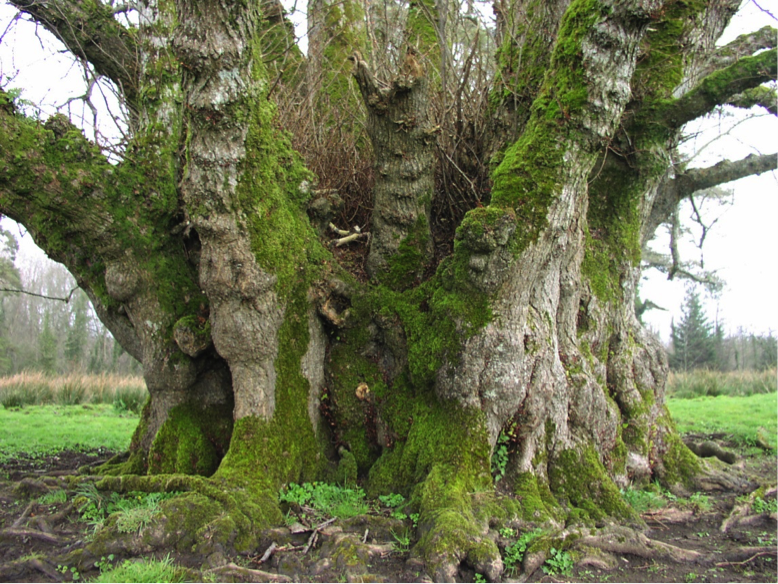
This common lime on the Florencecourt estate, Northern Ireland, is either an ancient coppice or a deliberate C18th bundle planting and contemporary with other lime planted nearby. (Photo: David Alderman)

The layering branches of this lime still appear to be attached but are now redundant as the layered branches are now growing independently as trees on their own root system. (Photo: David Alderman)
Common lime guidance
Mostly found in avenues the girth sizes of these will be considerably smaller than would normally be expected for their age. In avenues where trees are growing closely and their crowns are compromised, competing for light with their neighbours, 3-4m in girth is typical for trees of 250+ years of age. Without historical evidence it is often difficult to determine the age of an avenue. Re-planting within an avenue also leads to some uncertainty as to which trees are original and in some cases an avenue may be a complete replacement for one recorded originally as being planted in the 17thcentury.
There are two visually distinct clones of Common lime (Tilia x europaea) planted in the UK. These have been identified by Professor Donald Pigott as follows:
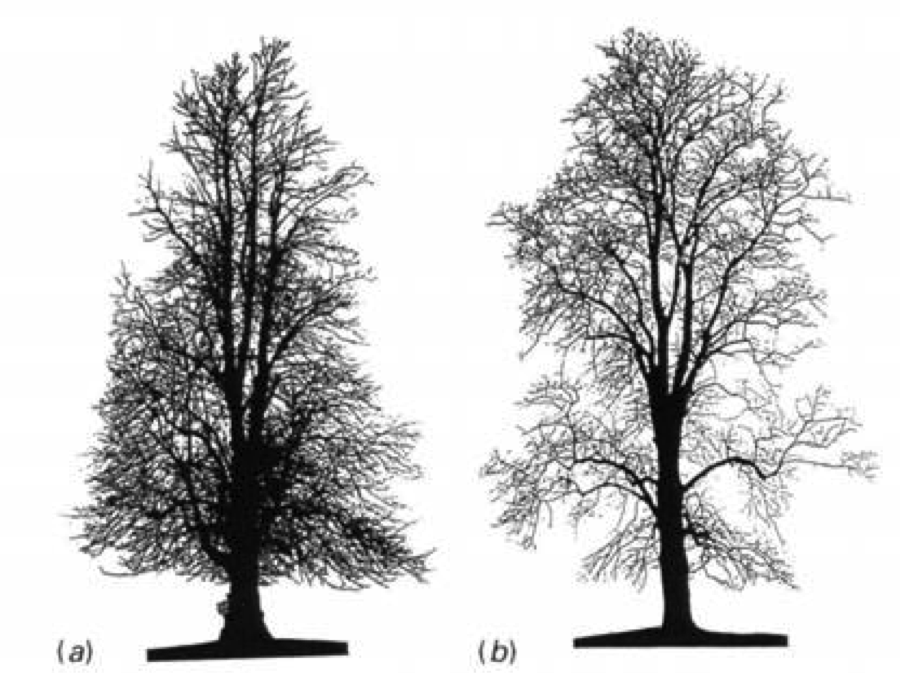
Left: Clonal group A. This clonal group appears morphologically identical with the clone 'Pallida' as it is defined in the Netherlands (Grootendorst, 1970) and Germany (Krussmann, 1977).
Right: Clonal group B. Trees of this clonal group planted before 1750 are at present known only from English parks. Although many of the distinctive characters are shared by the Dutch clone ' Svartelinde ' (Grootendorst 1970), they are not identical. The name 'Hatfield tall' is proposed for this clone. These old trees have cylindrical trunks with neither prominent buttresses nor epicormic burrs.
(Original drawings and text: Professor Donald Pigott)
Common lime clone 1 – ‘Pallida’
Identified by its deeply fluted trunk and mass of epicormic sprouts.
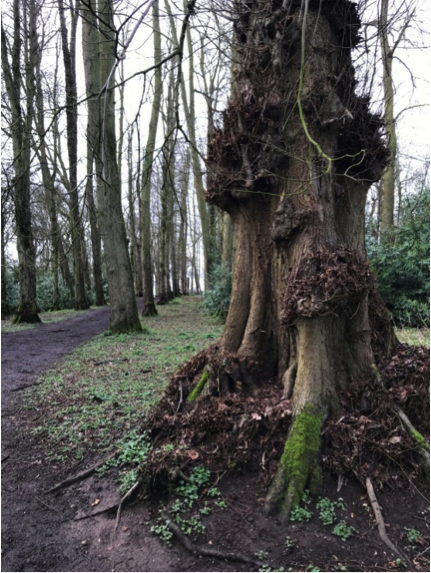
Common lime 'Pallida' showing multiple epicormic sprouts along the trunk. (Photo: David Alderman)
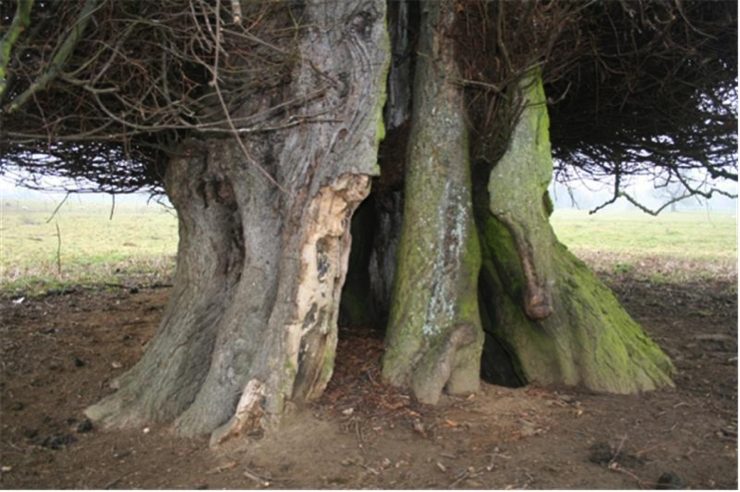
A late C17th planting of the common lime ‘Pallida’ at Belton House, Lincolnshire. Note the “skirt” of epicormic growth created by grazing cattle. (Photo: Louise Hackett)
Common lime clone 2 – ‘Hatfield Tall’
Identified by its cylindrical unfluted trunk and lack of sprouts, this tree often forks at c.4m and, as its name suggests, is frequently taller in stature than Clone 1. Considering their age, many old trees show few ancient characteristics and yet those that have fallen, or been felled, have invariably been found to be hollow. These trees may even be considered “notable” by condition and yet, if the historic evidence supports it, they will be ancient by age.

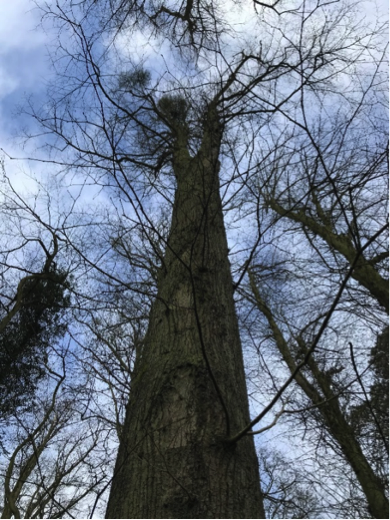
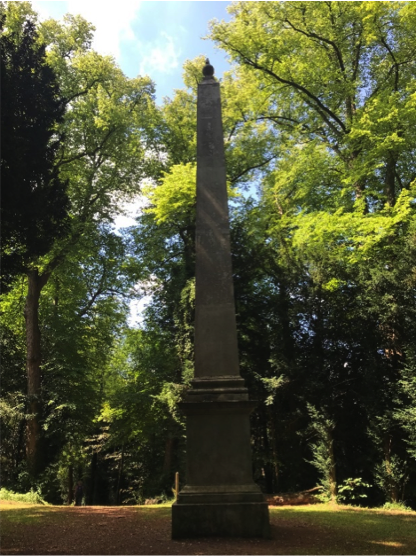
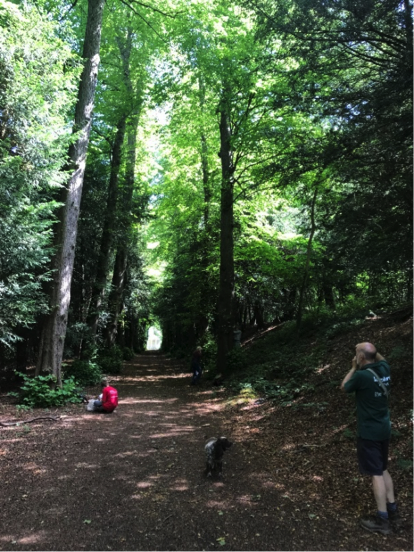
Above: ‘Hatfield Tall’ in the 1720’s designed landscape of Tring Park, Hertfordshire, owned by the Woodland Trust.
(All photos: David Alderman)
